Charles E W Bean, Diaries, AWM38 3DRL 606/254/1 - 1917 - 1933 - Part 16
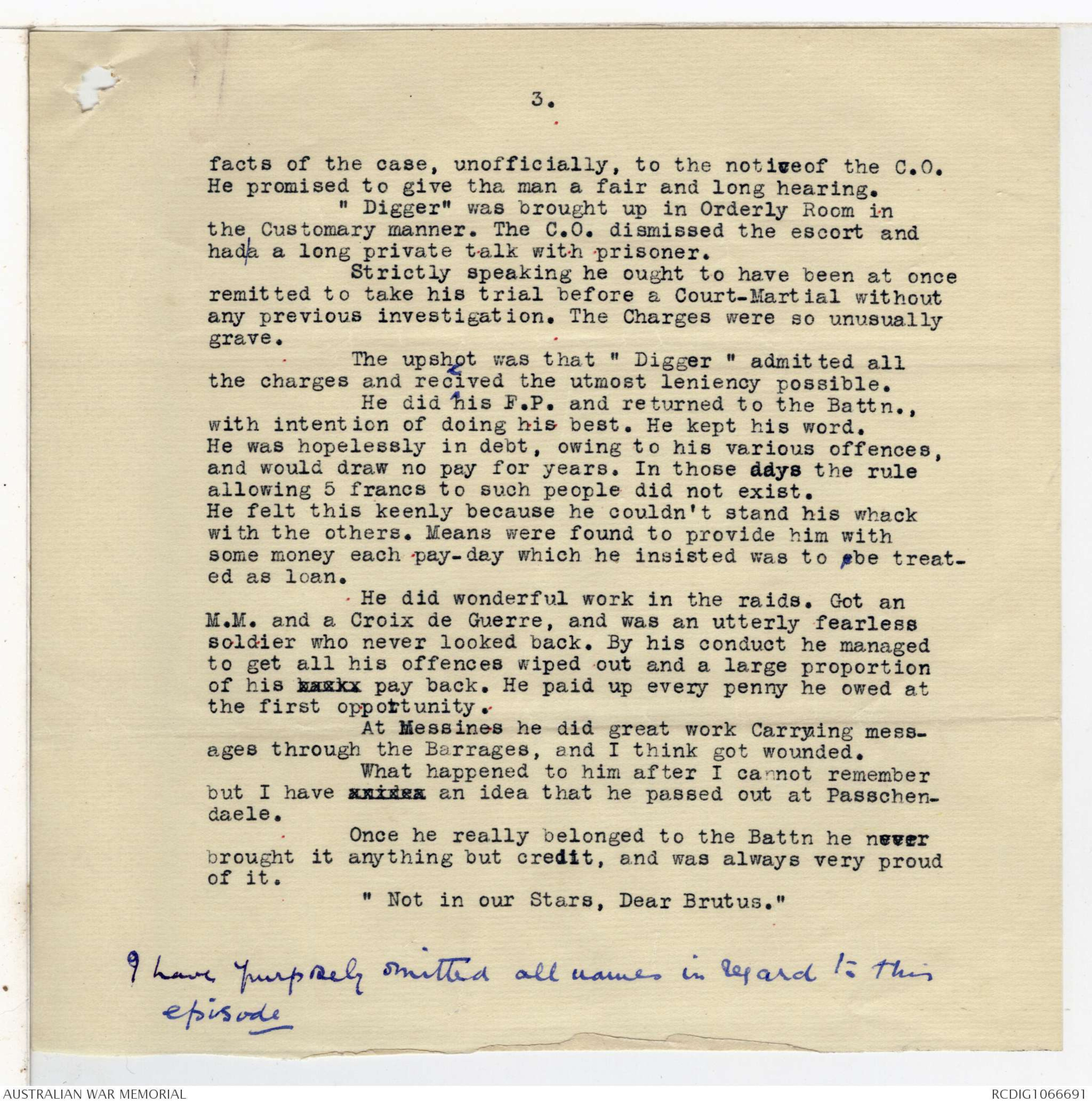
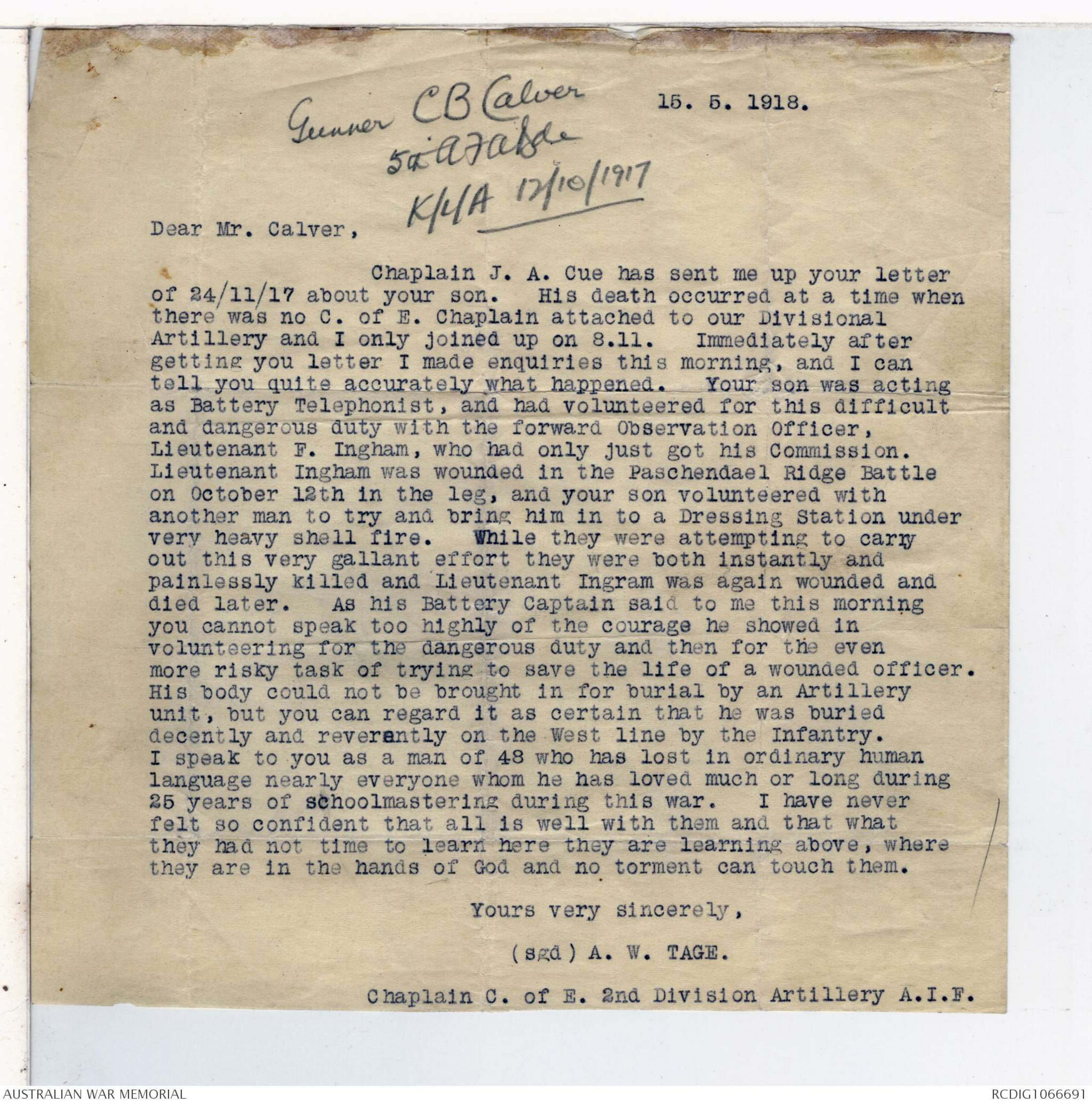
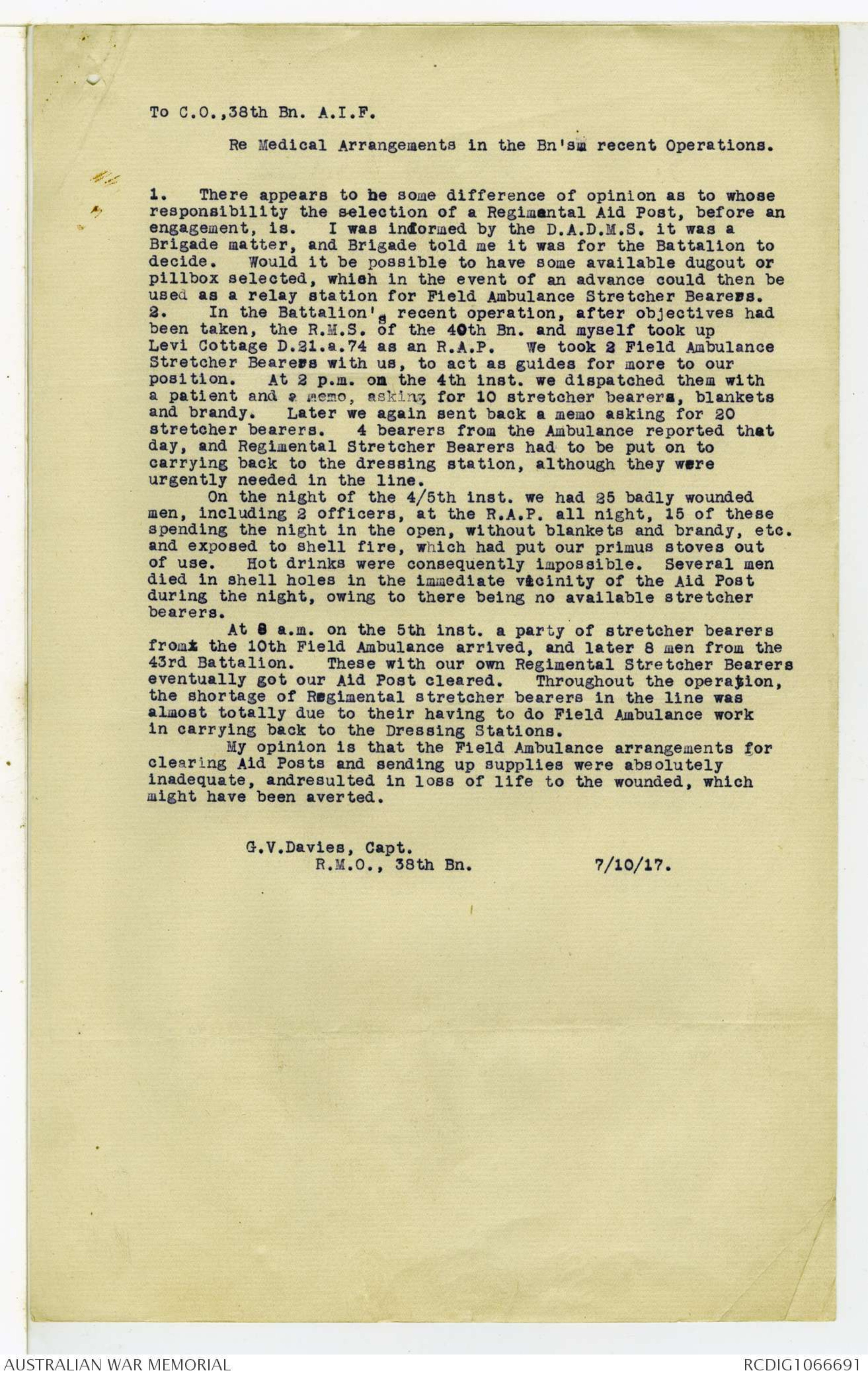


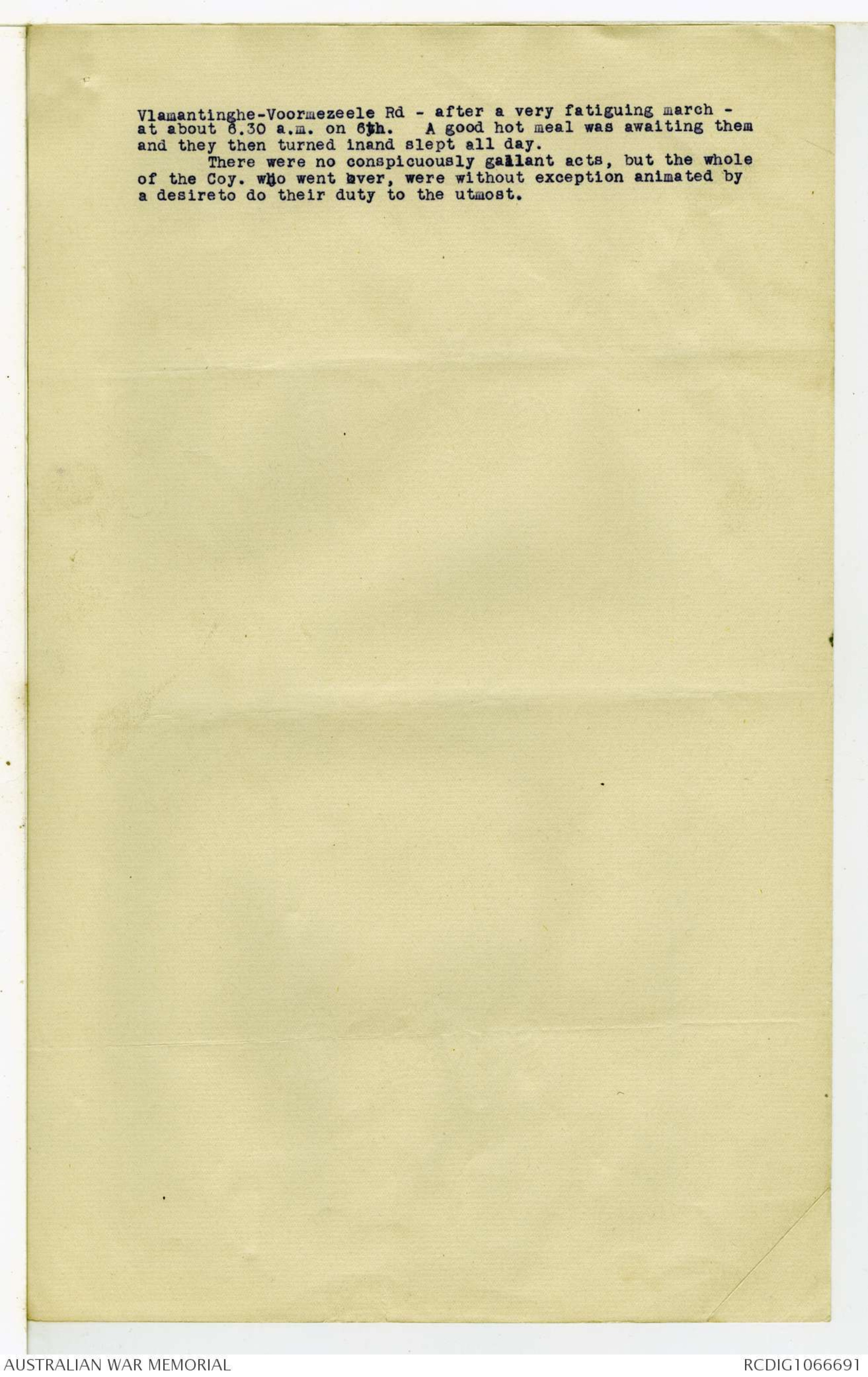
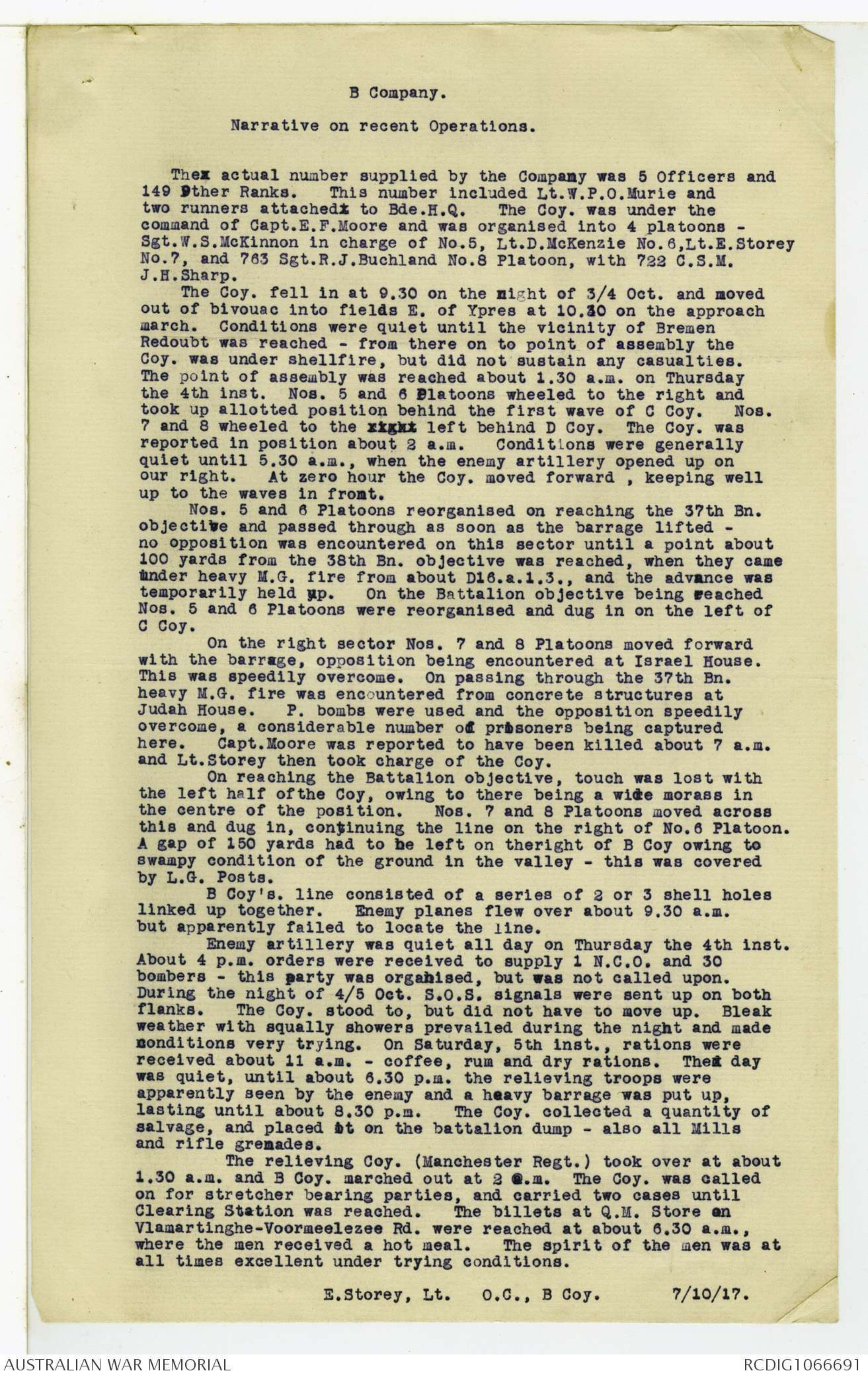
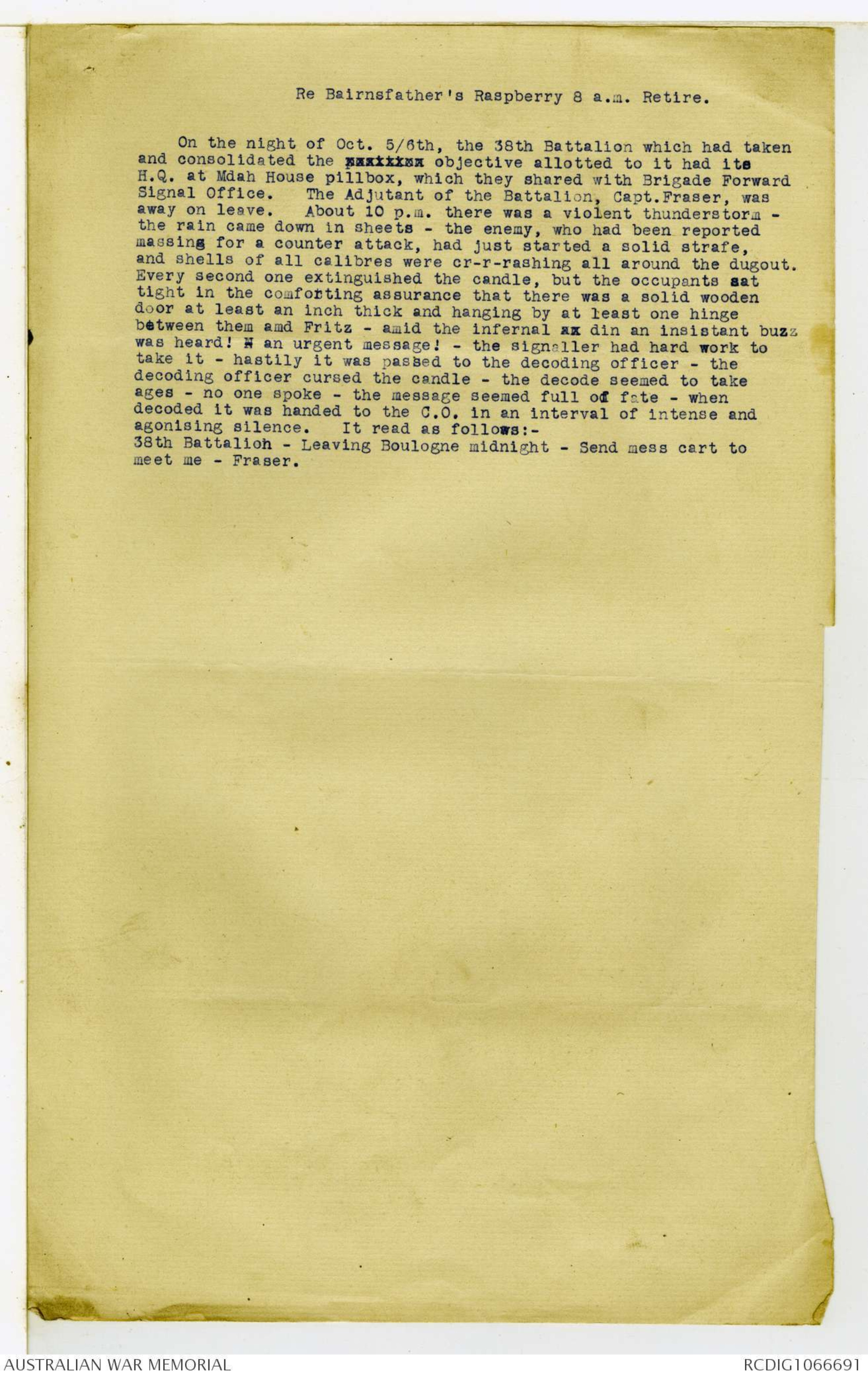

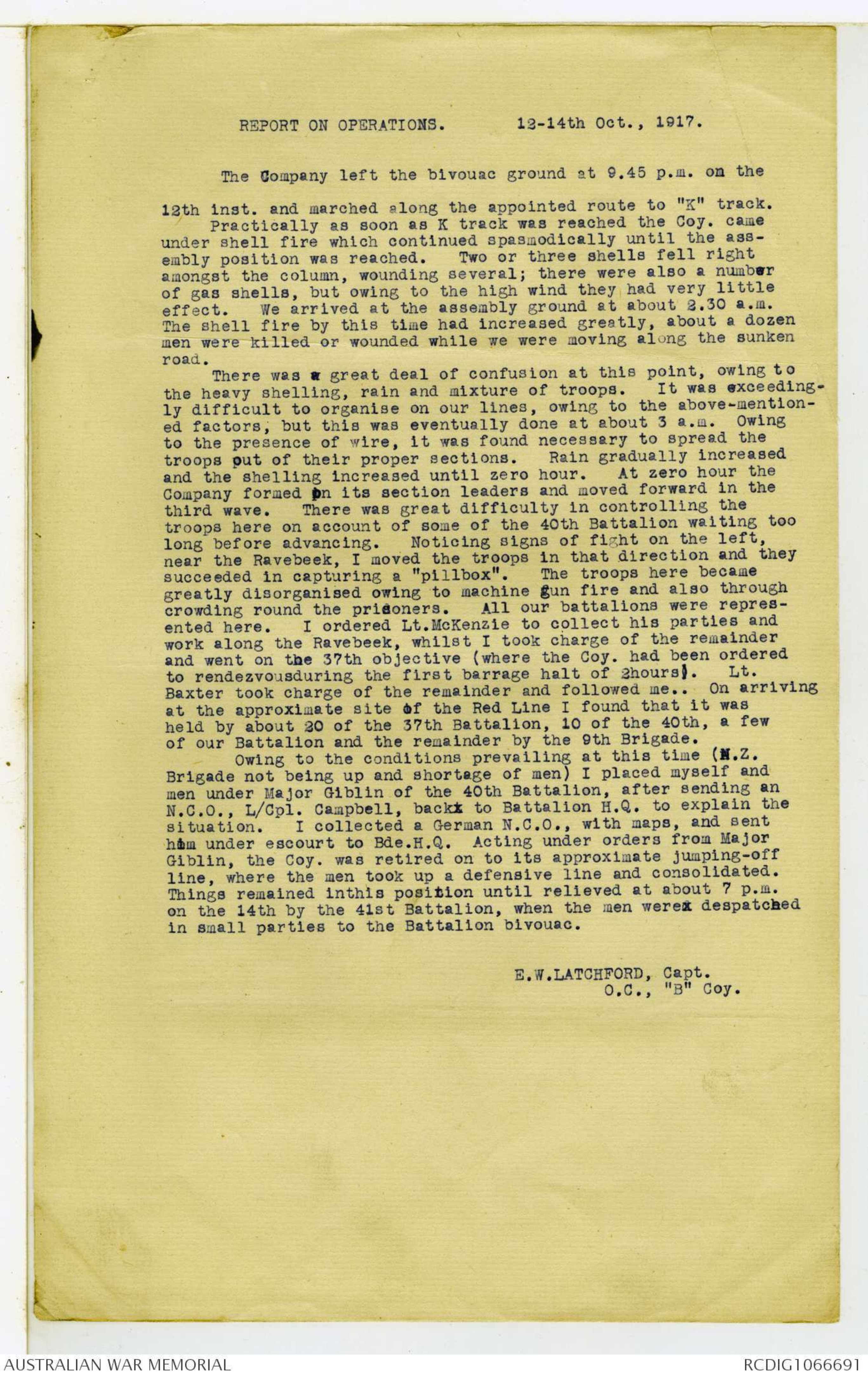
3.
facts of the case, unofficially, to the noticeof the C.0.
He promised to give tha man a fair and long hearing.
"Digger" was brought up in Orderly Room in
the Customary manner. The C.O. dismissed the escort and
had a a long private talk with prisoner.
Strictly speaking he ought to have been at once
remitted to take his trial before a Court-Martial without
any previous investigation. The Charges were so unusually
grave.
The upshot was that " Digger" admitted all
the charges and rec^eived the utmost leniency possible.
He did his F.P. and returned to the Battn.,
with intention of doing his best. He kept his word.
He was hopelessly in debt, owing to his various offences
and would draw no pay for years. In those days the rule
allowing 5 francs to such people did not exist.
He felt this keenly because he couldn't stand his whack
with the others. Means were found to provide him with
some money each pay-day which he insisted was to ebe
treated as loan.
He did wonderful work in the raids. Got an
M.M. and a Croix de Guerre, and was an utterly fearless
soldier who never looked back. By his conduct he managed
to get all his offences wiped out and a large proportion
of his xxxxxx pay back. He paid up every penny he owed at
the first opportunity.
At Messines he did great work Carrying messages
through the Barrages, and I think got wounded.
What happened to him after I cannot remember
but I have xxxxx an idea that he passed out at
Passchendaele.
Once he really belonged to the Battn he never
brought it anything but credit, and was always very proud
of it.
" Not in our Stars, Dear Brutus."
I have purposely omitted all names in Regard to this
episode.
Gunnr CB Calver
5th AIF A Bde
15. 5. 1918.
K/I/A 12/10/1917
Dear Mr. Calver,
Chaplain J. A. Cue has sent me up your letter
of 24/11/17 about your son. His death occurred at a time when
there was no C. of E. Chaplain attached to our Divisional
Artillery and I only joined up on 8.11. Immediately after
getting you letter I made enquiries this morning, and I can
tell you quite accurately what happened. Your son was acting
as Battery Telephonist, and had volunteered for this difficult
and dangerous duty with the forward Observation Officer,
Lieutenant F. Ingham, who had only just got his Commission.
Lieutenant Ingham was wounded in the Paschendael Ridge Battle
on October 12th in the leg, and your son volunteered with
another man to try and bring him in to a Dressing Station under
very heavy shell fire. While they were attempting to carry
out this very gallant effort they were both instantly and
painlessly killed and Lieutenant Ingram was again wounded and
died later. As his Battery Captain said to me this morning
you cannot speak too highly of the courage he showed in
volunteering for the dangerous duty and then for the even
more risky task of trying to save the life of a wounded officer.
His body could not be brought in for burial by an Artillery
unit, but you can regard it as certain that he was buried
decently and reverently on the West line by the Infantry.
I speak to you as a man of 48 who has lost in ordinary human
language nearly everyone whom he has loved much or long during
25 years of schoolmastering during this war. I have never
felt so confident that all is well with them and that what
they had not time to learn here they are learning above, where
they are in the hands of God and no torment can touch them.
Yours very sincerely,
(sgd) A. W. TAGE.
Chaplain C. of E. 2nd Division Artillery A.I.F.
To C.O.,38th Bn. A.I.F.
Re Medical Arrangements in the Bn'sm recent Operations.
1. There appears to he some difference of opinion as to whose
responsibility the selection of a Regimental Aid Post, before an
engagement, is. I was informed by the D.A.D.M.S. it was a
Brigade matter, and Brigade told me it was for the Battalion to
decide. Would it be possible to have some available dugout or
pillbox selected, which in the event of an advance could then be
used as a relay station for Field Ambulance Stretcher Bearers.
2. In the Battalion', recent operation, after objectives had
been taken, the R.M.S. of the 40th Bn. and myself took up
Levi Cottage D.21.a.74 as an R.A.P. We took 2 Field Ambulance
Stretcher Bearers with us, to act as guides for more to our
position. At 2 p.m. on the 4th inst, we dispatched them with
a patient and a memo, asking for 10 stretcher bearers, blankets
and brandy. Later we again sent back a memo asking for 20
stretcher bearers. 4 bearers from the Ambulance reported that
day, and Regimental Stretcher Bearers had to be put on to
carrying back to the dressing station, although they were
urgently needed in the line.
On the night of the 4/5th inst, we had 25 badly wounded
men, including 2 officers, at the R.A.P. all night, 15 of these
spending the night in the open, without blankets and brandy, etc.
and exposed to shell fire, which had put our primus stoves out
of use. Hot drinks were consequently impossible. Several men
died in shell holes in the immediate vicinity of the Aid Post
during the night, owing to there being no available stretcher
bearers.
At 8 a.m. on the 5th inst, a party of stretcher bearers
from the 1Oth Field Ambulance arrived, and later 8 men from the
43rd Battalion. These with our own Regimental Stretcher Bearers
eventually got our Aid Post cleared. Throughout the operation,
the shortage of Regimental stretcher bearers in the line was
almost totally due to their having to do Field Ambulance work
in carrying back to the Dressing Stations.
My opinion is that the Field Ambulance arrangements for
clearing Aid Posts and sending up supplies were absolutely
inadequate, andresulted in loss of life to the wounded, which
might have been averted.
G.V.Davies, Capt.
R.M.O., 38th Bn.
7/19/17.
Carrying Parties.
Re Operations on 4 and 5th Oct. 1917.
The approach march to the assembly point was successfully
carried out. The discipline was good and there was very little
noise. After being placed in position the enemy started shelling,
and the battalions in rear moved forwards and became mixed
up with the battalions in front.
As the carrying parties were to carry from a dump to be
established, in rear of the first objective, by the 37th Bn.,
I considered it better for the parties to go over just in rear
of the reserve Coy, as there was less chence of casualties
than if they waited near the point of assembly until the 37th dump
was established. Owing to the xxxxxxxx confusion at the Assembly Point,
the men became disorganised in giving over, and a number went in
with the Battalion to the second objective. The majority of these
came back, and I placed them all in shell holes till the 37th
dump should be established. When the latter failed to materialise,
the 37th Bn. sent men back to the Forward Brigade Dump to
carry to their objective, and the 38th Carrying Parties took the
stores direct from these men and carried to the 39th Bn. owing
to the 40th Bnm requiring ammunition. When an urgent message came
to the 37th Bn from the 40th Bn. through the Brigade, I sent
men back to the Forward Brigade dump, and they carried right
through to the 38th Bn. I did not establish myself at the 38th
dump, but stayed with the 37th Bn. to make sure that the supplies
went forward. The men ceased carrying when it became dark, owing
to it being impossible to cross the swamp in rear of the 2nd
objective except at certain places which were too difficult to
locate in the dark. On the second day, a forward Brigade dump
was established in front of Springfield,Farm, and the 38th parties
carried from the dump to the 38th and thence on to the 30th. The
supply of stores on the first day was unsatisfactory, owing to
the 37th Bn. dump not being established early enough, but the
arrangements on the second day worked well. The work of the
carrying parties was very difficult owing to the state of the
ground, and I consider that the men worked finely under the
circumstances. Two of the N.C.O's. were wounded early, but the
remaining two, Sgts. Runge, of C Coy., and Ross, of D Coy.
worked well, not only keeping the men going, but carrying also.
The work of the stretcher bearers throughout the whole
of the operations was very good, and I would particularly like
to mention that I saw Pte.Greenwood of C Coy. on both days going
continually backwards and forwards with wounded, even though the
enemy was shelling very heavily at times.
The work of the men in the line I did not see, owing to
my being with the 37th Battalion.
H.McCall, Lieut.
7/10/17.
Officer 1/C Carrying Parties, 38th Bn.
"A" Coy.
Narrative of recent Operations.
The Coy, moved from near Winnezele on che afternoon of 2nd,
and bivouaced on the night of 2/3rd in the fields E. of Ypres.
The 3rd was spent in issuing stores, grenades etc. (As near
Appendix t 1 to Bde. Orders as circumstances allowed) while the
Platoon Commanders reconnoitred the approach route. Fall in was
called et 9.30 p.m. on the night of 3/4th and the men were issued
with their final instructions, and at 10.15 p.m. the approach
march commenced. The commanders were Capt. H. Dench O.C., 446
Sgt.A.Clark, O.C. 1 Platoon, Lt.R.Kirgbride No. 2, 2150 Sgt.
F. Trebilcock No. 3, and Lieut.E.W.H.Major No. 4 Platoon.
3233 Sgt.O.A.Siden acted as C.S.M. The numbers that actually
took part in the assault were 3 officers, i50 O.R., plus 12 O.R.
attached to L.T.M. Bty. for carrying.
Owing to the roughness of the track the approach march w
was very slow, the jump off was veryypoorly marked, and there
was a good deal of confusion, small parties of moppers up, etc.
being out of place. The enemy were shelling indiscriminately,
but the Coy, had only one casualty (wounded) before zero.
It wasin position about 1.30 a.m.,sentries were posted and the
remainder tried to get some sleep. Slight shelling was kept
up until 5.30 a.m. without causing any casualties, and then heavy
artillery firing broke out on the right. The weather, which had
been threatening, now broke and continued wet during the whole
operation. The firing gradually extended along our front,
but all the shots passed overhead and fell further back. Under
the firing the men on the right started to go forward, and at
5.50 a.m. some of them must have nearly reached the enemy front
line. This Coy. remained fast. At 6 a.m. (zero) our barrage
opened and the men immediately pressed forward. Owing to the
darkness and the extreme roughness of the ground the advance was
very confused, and consisted of small groups of men all pressing
forward. Some opposition was experienced from a M.G. in a strong
post at about D.21.a.7.7., but a party worked round its flank
and silenced it with a P. bomb. Later more opposition was
encountered at Judah House (D.15.d.4.0.) The 37th obtained
their objective (the first) at 6;30 a.m., on time, but the
barrage appeared to rest longer than per syllabus, apparently
not lifting until 6.55 a.m.Opposition was encountered from a
strongly held strong point on about D.16.a.o.3, but was overcome
by N.2. and Aus. working round it on our left flank. The Bn.
reached its objective about 7.30 a.m., and immediately started
to consolidate. As soon as the Battalions going further on
passed through, the Coys were reorganised and a definite line
of trench marked and dug.
Enemy aircraft did not appear until about 9.30 a.m. and
his artillery was very quiet for the rest of the day. Apparently
they possessed no observation, as the shells all fell in certain
definite localities which were not occupied by us. In the
evening and night the S.O.S. signal was sent up on numerous
occasions from both flanks, but not from our front, and no
action was taken by the Coy, other then to stand to. At 4 p.m.
on the 4th orders were received to organise 4 platoons of a total
of 150 to take a further objective. This was done, but the
troops were not called on. At about 8 p.m., 4/5th, orders were
received to be ready to reinforce the 30th ahead, but no further
action was necessary.
The 5th was quiet and the weather showed some little
improvement. Rations and water arrived about 11 a.m. and were
distributed to the men. Enemy planes were much more active
and were repeatedly engaged by Lewis Gunners. In the afternoon
word was received that the Battn, would be relieved that
evening. About 6.30 p.m. the enemy opened a heavy box barrage
down both flanks of the sector and along our line, but by
judicious disposition casualties were avoided .The relief for
the Coy. arrived about 12.30 p.m. (5/6th) and the Cov. started
to move out about1.15 a.m. and arrived back in billets on the
Vlamantinghe-Voormezeele Rd - after a very fatiguing march -
at about 8.30 a.m. o 6th. A good hot meal was awaiting them
and they then turned inand slept all day.
There were no conspicuously gallant acts, but the whole
of the Coy, who went over, were without exception animated by
a desireto do their duty to the utmost.
B Company.
Narrative on recent Operations.
Thex actual number supplied by the Company was 5 Officers and
149 other Ranks. This number included Lt.W.P.O.Murie and
two runners attachedt to Bde.H.Q. The Coy. was under the
command of Capt.E.F.Moore and was organised into 4 platoons
Sgt.W.S.McKinnon in charge of No.5, Lt.D. McKenzie No. 6,Lt.E.Storey
No.7, and 763 Sgt.R.J.Buchland No.8 Platoon, with 722 C.S.M.
J.H.Sharp.
The Coy. fell in at 9.30 on the night of 3/4 Oct. and moved
out of bivouac into fields E. of Ypres at 10.30 on the approach
march. Conditions were quiet until the vicinity of Bremen
Redoubt was reached - from there on to point of assembly the
Coy. was under shellfire, but did not sustain any casualties.
The point of assembly was reached about 1.30 a.m. on Thursday
the 4th inst. Nos. 5 and 6 Platoons wheeled to the right and
took up allotted position behind the first wave of C Coy. Nos.
7 and 8 wheeled to the left behind D Coy. The Coy, was
reported in position about 2 a.m. Conditions were generally
quiet until 5.30 a.m., when the enemy artillery opened up on
our right. At zero hour the Coy, moved forward, keeping well
up to the waves in front.
Nos. 5 and 6 Platoons reorganised on reaching the 37th Bn.
objective and passed through as soon as the barrage lifted -
no opposition was encountered on this sector until a point about
100 yards from the 38th Bn. objective was reached, when they came
under heavy M.G. fire from about Dl6.a.1.3., and the advance was
temporarily held up. On the Battalion objective being reached
Nos. 5 and 6 Platoons were reorganised and dug in on the left of
C Coy.
On the right sector Nos. 7 and 8 Platoons moved forward
with the barrage, opposition being encountered at Israel House.
This was speedily overcome. On passing through the 37th Bn.
heavy M.G. fire was encountered from concrete structures at
Judah House. P. bombs were used and the opposition speedily
overcome, a considerable number of prisoners being captured
here. Capt. Moore was reported to have been killed about 7 a.m.
and Lt.Storey then took charge of the Coy.
On reaching the Battalion objective, touch was lost with
the left half ofthe Coy, owing to there being a wide morass in
the centre of the position. Nos. 7 and 8 Platoons moved across
this and dug in, continuing the line on the right of No.6 Platoon.
A gap of 150 yards had to he left on theright of B Coy owing to
swampy condition of the ground in the valley - this was covered
by L.G. Posts.
B Coy's. line consisted of a series of 2 or 3 shell holes
linked up together. Enemy planes flew over about 9.30 a.m.
but apparently failed to locate the line.
Enemy artillery was quiet all day on Thursday the 4th inst.
About 4 p.m. orders were received to supply i N.C.O. and 30
bombers - this party was organised, but was not called upon.
During the night of 4/5 Oct. S.O.S. signals were sent up on both
flanks. The Coy, stood to, but did not have to move up. Bleak
weather with squally showers prevailed during the night and made
conditions very trying. On Saturday, 5th inst., rations were
received about 11 a.m. - coffee, rum and dry rations. The day
was quiet, until about 6.30 p.m. the relieving troops were
apparently seen by the enemy and a heavy barrage was put up,
lasting until about 8.30 p.m. The Coy. collected a quantity of
salvage, and placed it on the battalion dump - also all Mills
and rifle grenades.
The relieving Coy. (Manchester Regt.) took over at about
i.30 a.m. and B Coy. marched out at 2 a.m. The Coy, was called
on for stretcher bearing parties, and carried two cases until
Clearing Station was reached. The billets at Q.M. Store on
Vlamartinghe-Voormeelezee Rd. were reached at about 6.30 a.m.
where the men received a hot meal. The spirit of the men was at
all times excellent under trying conditions.
E.Storey, Lt. O.C., B Coy.
7/10/17.
Re Bairnsfather's Raspberry 8 a.m. Retire.
On the night of Oct. 5/6th, the 38th Battalion which had taken
and consolidated the xxxxxxx objective allotted to it had its
H.Q. at Mdah House pillbox, which they shared with Brigade Forward
Signal Office. The Adjutant of the Battalion, Capt.Fraser, was
away on leave. About 10 p.m. there was a violent thunderstorm -
the rain came down in sheets - the enemy, who had been reported
massing for a counter attack, had just started a solid strafe,
and shells of all calibres were cr-r-rashing all around the dugout.
Every second one extinguished the candle, but the occupants sat
tight in the comforting assurance that there was a solid wooden
door at least an inch thick and hanging by at least one hinge
between them amd Fritz - amid the infernal xxx din an insistant buzz
was heard! an urgent message! - the signaller had hard work to
take it - hastily it was passed to the decoding officer - the
decoding officer cursed the candle - the decode seemed to take
ages - no one spoke - the message seemed full of fate - when
decoded it was handed to the C.O. in an interval of intense and
agonising silence. It read as follows:-
38th Battalion - Leaving Boulogne midnight - Send mess cart to
meet me - Fraser.
OPERATIONS OF "C" COMPANY, 12/10/17,
The approach march was full of incident right from the
time we got on to "K" track.The Bosch seemed to have good
information as to our movements and made things unpleasant for
us, especially in places which were in the low-lying parts where
the track was so defined as to leave no chance of our deviating
from the duck-board track. First of all the gas was the trouble,
but luckily the wind was too strong for the effect to be very
noticeable, and O consider that we were lucky that he did not
use shrapnel or H.E. instead of it.
No. 11 was the most unlucky of our platoons, as they got
a H.E. right in the centre of them, causing a great number of
casualties and givint the rest of the Company a severe shock.
When we reached the sunken road again there was a great number
of casualties, not on our own Company but in the Battalion. This
undountedly would have had a great effect on any other men bar
those tried and fit as our men were.
There was no confusion at the exact point of assembly, as
our guides did this work in an effecient and thorough manner.
The enemy got busy with a heavy barrage soon after we assembled,
and from the number left dead had a great effect on the strength
of the Battalion. I think I can say without fear of contradiction
that the Company went into action at the time of the "hop-
over" reduced by 10%.
From Zero on I got out of touch with the Company, as I
saw a position on our left that wanted mopping up, and went there
to try and clear it out, but found ong getting there, or rather
near there, that it was a veritable fort. We got three concrete
dugouts cleared, but the main one on the ridge, "Bellevue", was
unapproachable. I took up a position inx a dugout on the road
and kept up a continual observation on the Machine Gun positions
and snipers, hoping that I would be able to silence some of them,
at least. I know that we accounted for a number of snipers,
but the Machine Gunners we could not touch, as they appeared to
be in trenches or positions in rear of Bellevue, and consequently
out of our reach.
I think that this point, Bellevue, was the most important
line in the whole scheme, so far as I saw it From this point
the machine guns had an excellent field of fire in every direction
and could play havoc with our Battalion's advance on our frontage
and with the N.Z's. on theirs. In all my experience I have not
seen a better position for a M.G. strong point. The sniping
preparation on the part of the Bosch was excellent. Around the
position in which I had to take cover, he accounted for at least
50 of our men, movement in the open was absolutely impossible,
on the slightest movement a sniper invariably opened fire and
their aim was perfect. Communication was impossible, and I
could not get word to any of the units around. I sent two
runners to try and get in touch, but neither returned.
I decided to stay there in the dugout during the night
and evacuate in the morning just before dawn. This I did, and
it was only then that I found that the front objectives had been
evacuated.
From the accounts one hears from the men of the Coy.,
some got right uo to the village, but Capt.Latchford could give
a better account of that than I can. I should again like to
mention the general good work of the older men of the Company,
and particularly bring to notice the way the new men take to
the work.
James J.Munday, Lt.
A/O.C., C Coy.
REPORT ON OPERATIONS.
12-14th Oct., 1917.
The Company left the bivouac ground at 9.45 p.m. on the
12th inst, and marched along the appointed route to "K" track.
Practically as soon as K track was reached the Coy, came
under shell fire which continued spasmodically until the assembly
position was reached. Two or three shells fell right
amongst the column, wounding several; there were also a number
of gas shells, but owing to the high wind they had very little
effect. We arrived at the assembly ground at about 2.30 a.m.
The shell fire by this time had increased greatly, about a dozen
men were killed or wounded while we were moving along the sunken
road.
There was great deal of confusion at this point, owing to
the heavy shelling, rain and mixture of troops. It was exceedingly
difficult to organise on our lines, owing to the above-mentioned
factors, but this was eventually done at about 3 a.m. Owing
to the presence of wire, it was found necessary to spread the
troops put of their proper sections. Rain gradually increased
and the shelling increased until zero hour. At zero hour the
Company formed on its section leaders and moved forward in the
third wave. There was great difficulty in controlling the
troops here on account of some of the 40th Battalion waiting too
long before advancing. Noticing signs of fight on the left
near the Ravebeek, I moved the troops in that direction and they
succeeded in capturing a "pillbox”. The troops here became
greatly disorganised owing to machine gun fire and also through
crowding round the prisoners. All our battalions were represented
here. I ordered Lt.McKenzie to collect his parties and
work along the Ravebeek, whilst I took charge of the remainder
and went on the 37th objective (where the Co
to rendezvousduring the first barrage halt of 2hours). Lt.
Baxter took charge of the remainder and followed me.. On arriving
at the approximate site of the Red Line I found that it was
held by about 20 of the 37th Battalion, 10 of the 40th, a few
of our Battalion and the remainder by the 9th Brigade.
Owing to the conditions prevailing at this time (N.Z.
Brigade not being up and shortage of men) I placed myself and
men under Major Giblin of the 40th Battalion, after sending an
N.C.O., L/Cpl. Campbell, back to Battalion H.Q. to explain the
situation. I collected a German N.C.O., with maps, and sent
him under escourt to Bde.H.Q. Acting under orders from Major
Giblin, the Coy, was retired on to its approximate jumping-off
line, where the men took up a defensive line and consolidated.
Things remained inthis position until relieved at about 7 p.m.
on the 14th by the 41st Battalion, when the men were despatched
in small parties to the Battalion bivouac.
E.W.LATCHFORD, Capt.
O.C., "B" Coy.
 Sam scott
Sam scottThis transcription item is now locked to you for editing. To release the lock either Save your changes or Cancel.
This lock will be automatically released after 60 minutes of inactivity.